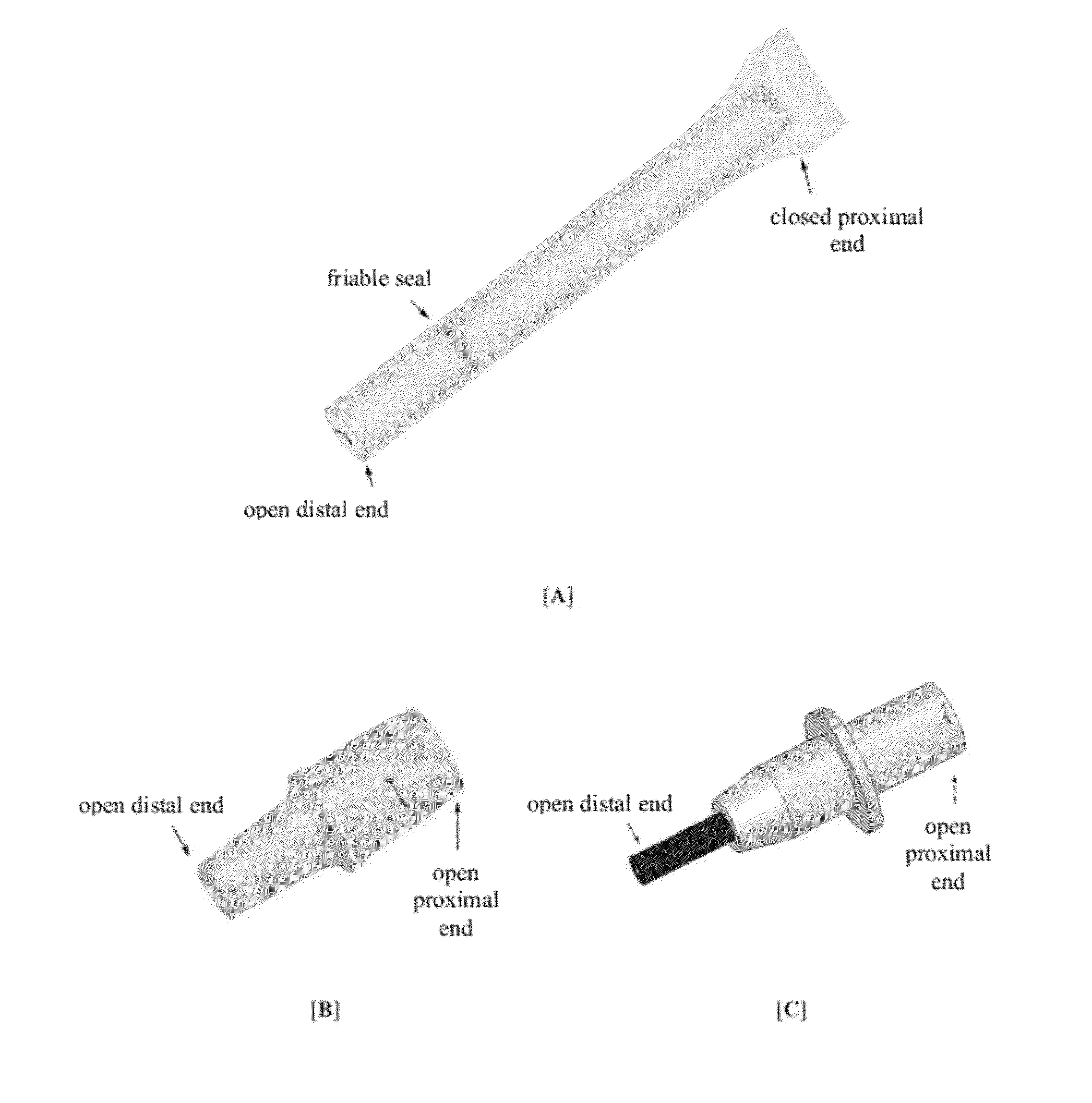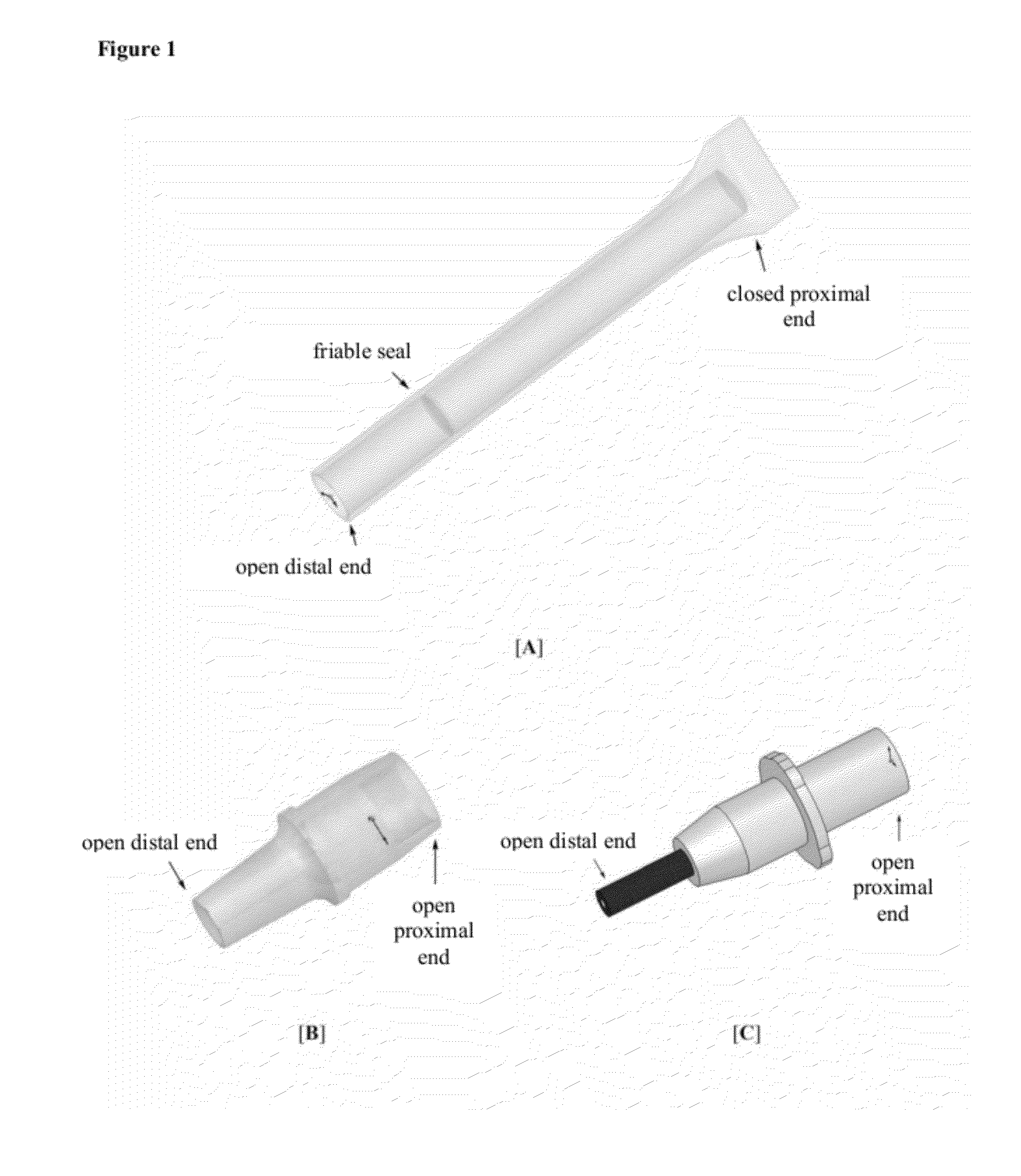Applicators for multiple component formulations and the like, and methods of use thereof
a technology of multiple component formulation and application method, which is applied in the field of applications for multiple component formulation and the like, can solve the problems of complex manipulative steps on the part of the user, difficult to complete the procedure without rendering the outlet portion of the syringe non-sterile, and difficult to load the syringe with the second ingredient without affecting the sterile characteristics of the syringe, etc., to achieve simple and inexpensive construction
- Summary
- Abstract
- Description
- Claims
- Application Information
AI Technical Summary
Benefits of technology
Problems solved by technology
Method used
Image
Examples
example 1
[0316]A nozzle tip was filled with a 0.072 mL aliquot of a solution made from 2 grams of 3400 molecular weight PEG-SPA (propionic acid succinimidyl ester of polyethylene glycol) in 4 mL of anhydrous acetone (0.5 g / mL) and allowed to dry. A 0.223 mL aliquot of PEI buffer (polyethyleneimine buffer) solution was placed into a JAC plastic amp. The impregnated tip was placed onto the JAC plastic amp and manually pressurized while the tip was placed over a weighing pan. The resulting solution was allowed to flow back through the applicator by reducing the manual compression force on tubular body. The pressurization and release (suck back) was repeated 2 additional times and the resulting solution was expressed out onto a weighing pan. The resulting solution gelled in approximately 30 seconds.
example 2
[0317]A nozzle tip was fitted with a piece of porous plastic (Porex Porous Plastics) of approximately 0.25″ diameter and 0.45″ in length. The location of the porous plastic piece was in the most proximal end of the nozzle tip. The porous plastic piece was impregnated with a 0.072 mL aliquot of a solution made from 2 grams of 3400 molecular weight PEG-SPA in 4 mL of anhydrous acetone (0.5 g / mL) and allowed to dry. A 0.223 mL aliquot of PEI buffer solution was placed into a JAC plastic amp. The impregnated tip was placed onto the JAC plastic amp and manually pressurized while the tip was placed over a weighing pan. The resulting solution was allowed to flow back through the applicator by reducing the manual compression force on the tubular body. The pressurization and release (suck back) was repeated 2 additional times and the resulting solution was expressed out onto a weighing pan. The resulting solution gelled in approximately 30 seconds.
example 3
[0318]An flow-thru brush was fitted with a piece of polymeric tubing to allow it to be mated into the open end of a JAC plastic amp and a piece of Poly-fil* polyester batting or other fibrous filter media material. The batting material was then impregnated with 0.072 mL of a 0.5 g / mL 3400 PEG-SPA in anhydrous acetone and allowed to dry. This impregnated brush applicator tip was then mated with a JAC plastic amp with 0.225 mL of PEI buffer solution. The plastic amp was then manually pressurized while the tip was placed over a weighing pan. The resulting solution was allowed to flow back through the applicator by reducing the manual compression force on the tubular body. The pressurization and release (suck back) was repeated several additional times and the resulting solution was expressed out onto a weighing pan. The resulting solution gelled in approximately 30 seconds.
PUM
 Login to View More
Login to View More Abstract
Description
Claims
Application Information
 Login to View More
Login to View More - R&D
- Intellectual Property
- Life Sciences
- Materials
- Tech Scout
- Unparalleled Data Quality
- Higher Quality Content
- 60% Fewer Hallucinations
Browse by: Latest US Patents, China's latest patents, Technical Efficacy Thesaurus, Application Domain, Technology Topic, Popular Technical Reports.
© 2025 PatSnap. All rights reserved.Legal|Privacy policy|Modern Slavery Act Transparency Statement|Sitemap|About US| Contact US: help@patsnap.com



